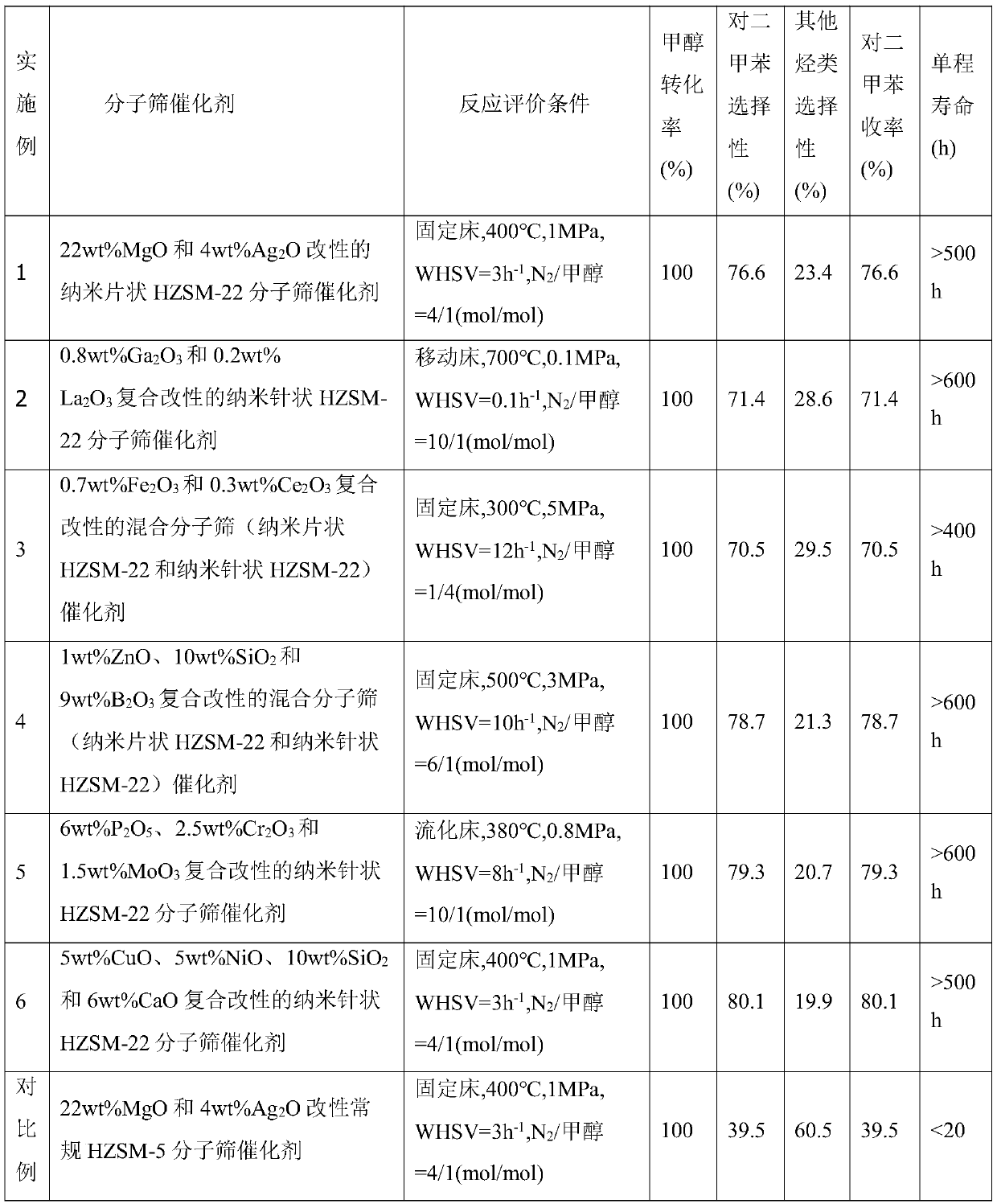Catalyst for efficiently synthesizing p-xylene through shape-selective aromatization of methanol
A p-xylene and catalyst technology, which is applied in the field of catalysts for efficient synthesis of p-xylene by methanol shape-selective aromatization, can solve the problems of short service life and low xylene selectivity, and achieve high aromatization efficiency
- Summary
- Abstract
- Description
- Claims
- Application Information
AI Technical Summary
Problems solved by technology
Method used
Image
Examples
Embodiment 1
[0019] 1) Take 13.8g of flaky crystals with a thickness of 80nm and a nano-flaky HZSM-22 molecular sieve with a silicon-aluminum atomic molar ratio of 5 and mix them with 1g of alumina binder. After stirring evenly, add an appropriate amount of dilute nitric acid to knead and extrude. , after drying at room temperature, calcined at 500° C. for 1 hour to obtain a strip-shaped catalyst with a cross-sectional diameter of 1.5 mm. Then the above-mentioned shaped unmodified catalyst particles were successively immersed in a certain concentration of magnesium nitrate aqueous solution and silver nitrate aqueous solution for 12 hours, and the loading capacity of magnesium oxide and silver oxide was determined by the water absorption and solution concentration of the unmodified catalyst. The samples were 4.4g and 0.8g, and the impregnated samples were dried at 120°C for 6 hours, and then fired at 500°C for 1 hour. Finally, a nanosheet HZSM-22 molecular sieve catalyst compositely modifie...
Embodiment 2
[0022] 1) Weigh 18.8g of nano needle-shaped HZSM-22 molecular sieve with a silicon-aluminum atomic molar ratio of 500 and acicular crystal cut-off surface diameter of 100nm, mix it with 1g of silicon oxide binder, roll into a ball, and dry it at room temperature , Calcined at 500°C for 1 hour to obtain spherical catalyst particles with a diameter of 1.5mm. Then the unmodified catalyst of above-mentioned gained shaping is successively respectively in the gallium nitrate of certain concentration and the excessive immersion of lanthanum nitrate aqueous solution for 12 hours, determine the loading capacity of gallium oxide and lanthanum oxide respectively by the water absorption of unmodified catalyst and solution concentration: 0.16g and 0.04g, the impregnated samples were dried at 120°C for 6 hours, and then calcined at 500°C for 1 hour. Finally, a nanoacicular HZSM-22 molecular sieve catalyst compositely modified with 0.8wt% gallium oxide and 0.2wt% lanthanum oxide was prepared...
Embodiment 3
[0025]1) Weigh 10.8g of nano-flaky HZSM-22 molecular sieves with a silicon-aluminum atomic molar ratio of 2 and a flaky crystal thickness of 300nm, and 3g of nanoneedles with a silicon-aluminum atomic molar ratio of 40 and acicular crystal cut-off diameter of 500nm HZSM-22 molecular sieves were mixed, and then 6g of silica binder was added, kneaded, extruded into strands, dried at room temperature, and roasted at 500°C for 1 hour to obtain strip-shaped catalyst particles with a cross-sectional diameter of 1.5mm. Then the above-mentioned shaped unmodified catalyst particles were successively immersed in a certain concentration of ferric nitrate and cerium nitrate aqueous solution for 12 hours, and the loading capacity of iron oxide and cerium oxide was determined by the water absorption and solution concentration of the unmodified catalyst. 0.14g and 0.06g, the impregnated samples were dried at 120°C for 6 hours, and then calcined at 500°C for 1 hour. A hybrid molecular sieve (...
PUM
 Login to View More
Login to View More Abstract
Description
Claims
Application Information
 Login to View More
Login to View More - R&D
- Intellectual Property
- Life Sciences
- Materials
- Tech Scout
- Unparalleled Data Quality
- Higher Quality Content
- 60% Fewer Hallucinations
Browse by: Latest US Patents, China's latest patents, Technical Efficacy Thesaurus, Application Domain, Technology Topic, Popular Technical Reports.
© 2025 PatSnap. All rights reserved.Legal|Privacy policy|Modern Slavery Act Transparency Statement|Sitemap|About US| Contact US: help@patsnap.com

